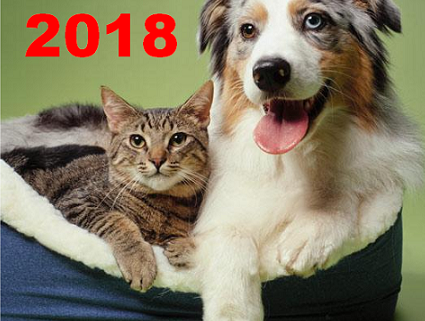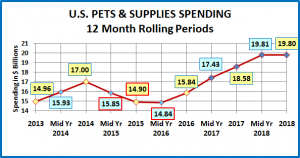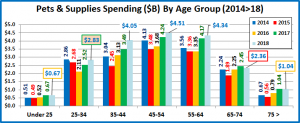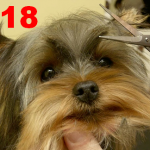2018 U.S. PET SUPPLIES SPENDING $19.80B…UP ↑$1.22B
Due to a drop in Pet Food spending, Total Pet spending moved up only slightly to $78.60B in 2018, a $1.47B (1.9%) increase from 2017. The Supplies segment exceeded this pace as spending reached $19.8B, up $1.22B (6.6%). (Note: All numbers in this report come from or are calculated by using data from the US BLS Consumer Expenditure Surveys)
The first half of 2018 continued an upturn in Supplies spending which began in the second half of 2016. However, in the second half of the year spending flattened out. In this report we’ll “drill down” into the data to try to determine what and who are “behind” the lift and subsequent pause in 2018 Pet Supplies Spending.
In 2018, the average household spent $150.62 on Supplies, up 5.4% from $142.90 in 2017. (Note: A 2018 Pet CU (67%) Spent $224.81) This doesn’t exactly match the 6.6% total $ increase. Here are the specific details:
- 1.1% more CU’s
- Spent 4.8% more $
- 0.6% more often
Let’s start with a visual overview. The chart below shows recent Supplies spending history.
Since the great recession, spending trends in the Supplies segment have been all about price – the CPI. Although many supplies are needed by Pet Parents, when they are bought and how much you spend is often discretionary. Additionally, many of the product categories in this segment are now considered commodities, so price is the main driver behind consumer purchasing behavior. When prices fall, consumers are more likely to buy more. When they go up, consumers spend less and/or buy less frequently.
2014 was the third consecutive year of deflation in Supplies as prices reached a level not seen since 2007. Consumers responded with a spending increase of over $2B. Prices stabilized and then moved up in 2015.
In 2015 we saw how the discretionary aspect of the Supplies segment can impact spending in another way. Consumers spent $5.4B for a food upgrade and cut back on Supplies – swapping $. This, in conjunction with inflation, caused supplies to suffer as consumers spent 4.1% less, but they bought 10% less often. That drop in purchase frequency drove $1.6B (78%) of the $2.1B decrease in Supplies spending.
In 2016, supplies’ prices flattened out and consumers value shopped for their upgraded food. Supplies spending stabilized and began to increase in the second half. In 2017 supplies prices deflated, reaching a new post-recession low. The consumers responded with a huge $2.74B increase in Supplies spending that was widespread across demographic segments. An important factor in the lift was an increase in purchase frequency which was within 5% of the 2014 rate.
In 2018 prices started to move up in April and rapidly increased later in the year due to the impact of new tariffs. By December, Supplies prices were 3.3% higher than a year ago. This explains the initial growth and pull back in spending.
That gives us an overview of the situation. Now let’s look at the “who” behind the numbers. First, we’ll look at spending by income level, the most influential demographic in Pet Spending.
National: $150.62 per CU (+5.4%) – $19.8B – Up $1.22B (+6.6%). (1st Half: +$1.23B; 2nd Half -$0.01B). Specifically:
In 2018 The spending increase was driven by the $100K+ group, those least affected by price, but it is not that simple.
- <$30K (28.7% of CU’s)- $70.09 per CU (+2.3%)- $2.64B– Down $0.05B (-1.7%). (1st Half: +$0.12B; 2nd Half: -$0.17B) This group is very price sensitive as is evidenced by their spending drop due to the price increase. However, there is more to the story. Their CU supplies spending actually increased 2.3%, but the number of CU’s fell 4%.
- $30K>70K (31.0% of CU’s)- $129.31 per CU (+2.3%) $5.26B Up $0.11B (+2.2%). (1st Half: +$0.18B; 2nd Half -$0.07B) This lower income group closely matches the national pattern and is the only group besides $150K+ to have annual increases since 2015. As you can see, they also reflect the price sensitivity of the segment.
- $70>$100K (14.5% of CU’s) – $150.95 per CU (-4.0%) – $2.88B Down $0.16B (-5.2%). (1st Half: -$0.25B; 2nd Half +$0.09B) This middle-income group is the only group to have a drop in both CU average and total $. They fell 2% in the number of CU’s, but they also had an overall decrease in their total consumer spending, not just pet.
- $100K>$150K (13.1% of CU’s) – $219.71 per CU (+12.4%) – $3.79B Up $0.56B (+17.5%). (1st Half: +$0.27B; 2nd Half +$0.29B) This group is growing and size and spending. They had the biggest percentage increase in Total $ and a huge lift in CU spending. The price increase has had no impact… so far.
- $150K> (12.7% of CU’s) – $312.98 per CU (-1.1%) – $5.22B Up $0.75B (+16.7%). (1st Half: +$0.91B; 2nd Half -$0.16B) The lift in this group was driven by the $200K+ group. The drop in CU average came from the $150>199K group. Both groups spent slightly less in the 2nd Half. Money matters in Supplies but price increases can impact anyone.
The increase was driven by $100K+, but the performance of the $30>70K group showed that pet parenting is widespread across income groups. We also saw that price is a key factor to almost everyone in a discretionary segment like Supplies.
Now, we’ll look at spending by Age Group.
National: $150.62 per CU (+5.4%) – $19.8B – Up $1.22B (+6.6%). (1st Half: +$1.23B; 2nd Half -$0.01B). Specifically:
The increase was driven by 25>54 year olds, Millennials and Gen Xers, but every group but the 65>74 year olds spent the same or more on Supplies in 2018. However, the price increase had a definite impact. Here are the details.
- 45>54 (17.5% of CU’s) $195.56 per CU (+8.7%) – $4.51B – Up $0.27B (+6.3%). (1st Half: +$0.31B; 2nd Half: -$0.05B) This highest income age group has been the leader in Supplies spending since 2007. Fewer CU’s (-2.2%) spent 17.4% more on supplies, 7.4% less often. A drop in purchase frequency often comes with a price increase.
- 35>44 (16.7% of CU’s) $184.23 per CU (+11.3%) – $4.05B – Up $0.56B (+16.0%). (1st Half: +$0.36B; 2nd Half: +$0.20B) This group is second in income and overall expenditures. They had the biggest lift in Supplies spending, but growth has been exceptionally strong for the last 3 years. 4.3% more CU’s spent 3.6% more $, 7.4% more often.
- 25<34 (16.2% of CU’s) $132.72 per CU (+12.0%) – $2.83B – Up $0.30B (+12.0%). (1st Half: +$0.19B; 2nd Half: +$0.12B) These Millennials are the only group spending less on Supplies in 2018 than in 2014. During that time, they have upgraded their food and increased their veterinary spending. However, in 2018 they turned their attention back to Supplies as 0.1% more CU’s spent 5.3% more on supplies, 6.3% more often.
- 55>64 (18.6% of CU’s) $177.48 per CU (+5.3%) – $4.34B – Up $0.18B (+4.3%). (1st Half: +$0.23B; 2nd Half: -$0.05B) In 2017 this “Boomer” group found the lowest Supplies prices since 2007 very alluring. They bought $0.82B more. The growth continued into 2018. Then prices turned sharply upward in the 2nd half and the growth stalled. 0.9% less CU’s spent 3.5% more on Supplies, 1.7% more often.
- 65>74 (14.7% of CU’s) $122.01 per CU (-7.7%) – $2.36B – Down $0.09B (-3.8%). (1st Half: +$0.10B; 2nd Half: -$0.19B) There a lot of “price sensitive” retirees in this group. When prices turned up, they immediately cut back on spending. 4.2% more CU’s spent 11.1% less, 3.9% more often.
- <25 (5.8% of CU’s) $88.21 per CU (+0.7%) – $0.67B- Up $0.004B (+0.6%). (1st Half: +$0.02B; 2nd Half: -$0.02B) This small group had the same # of CU’s, spent 2.9% more $, but 2.2% less often. The net result was that the 2nd half loss essentially wiped out the small gain in the first half.
- 75> (10.4% of CU’s) $75.87 per CU (-3.7%) – $1.04B, Even $0.000B (0.0%). (1st Half: +$0.03B; 2nd Half: -$0.03B) This group is truly price sensitive as they spend 18% more than they earn. Like the youngest group, their 2nd half spending cut back produced a net “no gain” for the year. 3.9% more CU’s spent 5.8% more, 9.0% less often.
The impact of the price increase was readily apparent in this category. While 6 of 7 groups maintained or increased their Spending in 2018, 5 of 7 had decreases in the 2nd half. The other 2 had increases but they were 40% less than the 1st half.
Next, let’s take a look at some other key demographic “movers” in 2018 Pet Supplies Spending. Those boxed in black are different from 2017. If they are boxed in red, they flipped from 1st to last or vice versa.
There was some turmoil. 18 of 24 segments (75%) are different from 2017. 3 flipped from 1st to last and 1 went from last to 1st. Overall, the winners are definitely stronger than the losers. That’s what produced the $1.22B increase.
Three categories: Housing, Area & CU size had no negative segments. You see some of the usual “suspects on the “plus” side, like White, Not Hispanics, Homeowners with mortgages, Suburbanites and Married Couples only. The importance of income to Supplies spending is also clear with $150K+, 2 Earners and College Grads all having the biggest increases.
The positive influence of the younger crowd is very apparent with Millennials, 35 to 44 year olds, 4 People CU’s and white collar workers coming out on top.
On the downside, you see the impact of the strong inflation on Supplies Spending. There are a number of lower income, and/or price sensitive groups who spent less on Supplies in 2018. They include, Retirees, 65 to 74 year olds, Single Parents, 2+ people CU’s with only 1 Earner and those without a high school diploma.
The biggest “losers” in 2018 Supplies Spending were the Baby Boomers. They were down -$0.62B after an increase of $1.11B in 2017. That’s quite a turnaround. I looked a little closer and found that they were up $0.02B in the 1st Half of 2018, then went down -$0.64B in the 2nd half. In the Food Segment we saw evidence of reduced spending due to a number of their children moving out on their own. This undoubtedly contributed to the drop in Supplies $, but the drop also coincided with the price increase. I decided to look closer at the impact of that inflation across the demographics.
The following chart shows the biggest 2nd Half “losers” in 2018 Supplies Spending along with the winner in the category. To make the list, a segment had to have a minimum change of $0.1B.
Supplies Spending started out strong in 2018. In the 1st half, 67 of 82 demographic segments (82%) spent more. Then came the 2nd Half. Prices increased by 1.7% and only 38 segments (44%) had a spending increase over a year ago. By year end, 64 segments spent more on Supplies (78%). 2nd half numbers were not all bad. 5 segments that started out negative ended up on the plus side for the year. However, 8 segments that were positive in the 1st Half ended up spending less for the year because of the 2nd Half. Plus, some of the effect of inflation was hidden. 30 segments increased spending in both halves. However, 24 of them 80% had a smaller increase in the second half. The inflation had a broad impact.
The spending decrease was -$0.01B in the 2nd Half of 2018. In a couple of cases the behavior was clearly divided.
Education: College Grads +$0.30B; <College -$0.31B
Age: 25>44 +$0.32B; 45> -0.32B
The 2nd Half numbers strongly reinforce the importance of two demographic categories in Supplies Spending – Income & Age
Income – Supplies Spending is very price sensitive. Strong inflation causes low income and financially pressured groups to spend less – <$50K (46% of CU’s), 2+CU’s with 1 or no earners, Retirees, <College grads, Married Couples with Children, 4 Person CU’s. These groups all have monetary concerns. $100>149K, 3 Earners, College Grads, Homeowners with a paid off mortgage that aren’t Retirees are generally under less financial pressure.
Age – Perhaps, it is because they are less focused on “need” and have a more expansive and active “take” on Pet Parenting than their older counterparts, but Supplies Spending has always skewed towards the younger groups. The spending in both halves of 2018 by 25>44 yr olds, Millennials and 2+ Unmarried Adults reinforces this observation.
2018 definitely validates the price sensitivity of Supplies. After 24 months of consistent, strong growth, +$4.97B, spending turned down in the second half of 2018. The most likely cause – 1.7% inflation, driven by tariffs. What comes next? Inflation continued into 2019 growing another 1.7% in the first half. In fact, Supplies’ prices in the 1st half of 2019 were 3.4% above the same period in 2018. This doesn’t bode well for Supplies $ in 2019, but we’ll have to wait and see.








